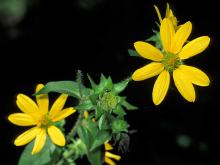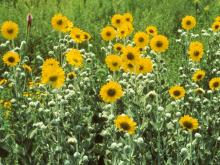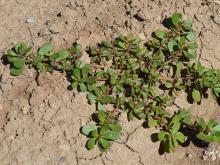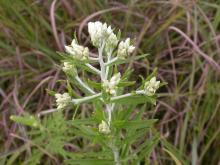Wildflowers, Grasses and Other Nonwoody Plants
Media

Species Types
Scientific Name
Sagittaria spp.
Description
Arrowheads are aquatic plants with erect, usually arrow-shaped leaves and distinctive three-petaled flowers. They are often called duck potatoes because ducks, geese, and swans relish the tuberlike rootstocks.
Media

Species Types
Scientific Name
Silphium asteriscus
Description
Starry rosinweed is a relatively short rosinweed that grows scattered mostly in the southern half of Missouri. It blooms May through September.
Media

Species Types
Scientific Name
Helianthus spp.
Description
Most people recognize sunflowers when they see them, with their bright yellow ray flowers and rather flattened center of dark disk flowers. There are 16 species of Helianthus in Missouri.
Media

Species Types
Scientific Name
Portulaca oleracea
Description
Purslane can be an aggressive pest in gardens and is one of the worst agricultural weeds in the world. Meanwhile, it’s also a favorite wild vegetable served cooked or raw, and many people cultivate it.
Media

Species Types
Scientific Name
Helenium virginicum
Description
Virginia sneezeweed is the rarest of Missouri’s four sneezeweeds. A state endangered and federally threatened species, it occurs in about 60 sites in our southern Ozark counties, primarily in boggy, sinkhole pond habitats.
Media

Species Types
Scientific Name
Pseudognaphalium obtusifolium (syn. Gnaphalium obtusifolium)
Description
Sweet everlasting, or old field balsam, catches your eye with its clusters of white, peg-shaped flowerheads and white branches that contrast with the narrow green leaves. It occurs statewide, in a variety of open, sunny habitats.
Media

Species Types
Scientific Name
Xanthium strumarium
Description
Common cocklebur occurs statewide in open, disturbed, lowland habitats. It is a common weed in crop fields. It has wide, rough, coarsely toothed leaves; stout, often purple-speckled stems; and characteristic burs with hooked spines.
Media

Species Types
Scientific Name
Verbesina alternifolia (syn. Actinomeris alternifolia)
Description
Yellow ironweed is a tall native perennial wildflower. Its yellow petal-like rays droop down, making the many flowerheads look like small, ragged sunflowers. The stems are winged, especially toward the bottom of the plant.
Media

Species Types
Scientific Name
Viola spp.
Description
Violets, as a group, are fairly easy to identify, with their colorful five-petaled “faces” so welcome in springtime. Missouri has 17 species, and some are confusingly similar. This page introduces them as a group.
Media

Species Types
Scientific Name
Packera spp. (formerly Senecio spp.)
Description
Ragworts, or groundsels, have several common names, and separating the different species can be a little tricky. But members of genus Packera, with their bright yellow daisy-like flowers, are distinctive as a group. Seven species have been recorded in Missouri.
See Also
About Wildflowers, Grasses and Other Nonwoody Plants in Missouri
A very simple way of thinking about the green world is to divide the vascular plants into two groups: woody and nonwoody (or herbaceous). But this is an artificial division; many plant families include some species that are woody and some that are not. The diversity of nonwoody vascular plants is staggering! Think of all the ferns, grasses, sedges, lilies, peas, sunflowers, nightshades, milkweeds, mustards, mints, and mallows — weeds and wildflowers — and many more!





















